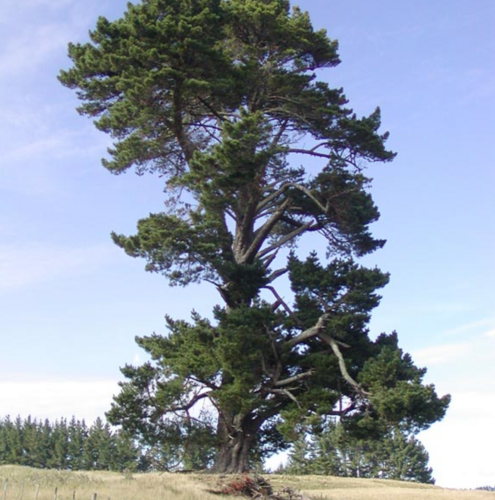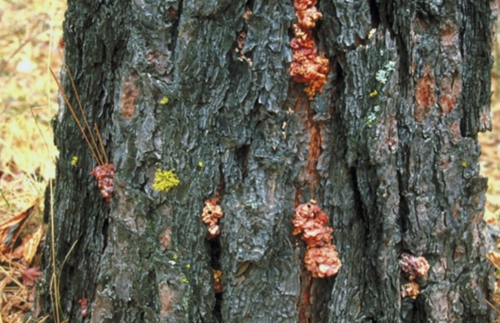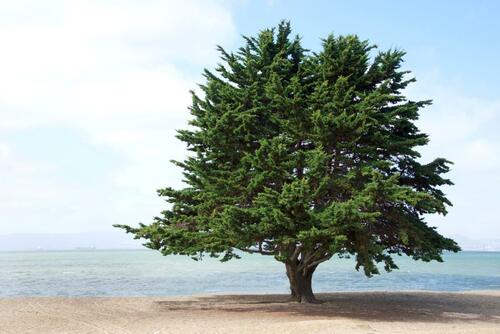The Silent Threat: Red Turpentine Beetle in Monterey Pine (Pinus radiata) Trees in the Bay Area
Introduction
Monterey pine ( Pinus radiata ) trees hold a special place in the hearts of Bay Area residents. As one of the most common and iconic tree species that line our streets and forests, it’s hard to imagine life without them. But there’s a silent threat looming over these majestic trees—the red turpentine beetle. In this blog, we’ll discuss the prevalence of red turpentine beetle infestations in Monterey pine trees, their life cycle and behavior, identifying factors that make them vulnerable, signs of infestations, and strategies for safeguarding our beloved trees .
The Red Turpentine Beetle: A Silent Threat
The Red Turpentine Beetle (RTB) is a bark beetle notorious for its destructive capabilities. Native to North America, this beetle primarily targets pines, including the Monterey pine, posing a significant threat to the tree’s health. The threat lies in its method of attack, which targets the lower trunk of the tree. Upon infestation, these beetles push toxic sap into the tree, disrupting vital processes such as sap flow, respiration, and photosynthesis, ultimately causing the death of the tree.
These beetles are not simply nuisances; they pose a significant risk to the health and longevity of Monterey pines. Their infiltration can weaken and devastate entire stands of these majestic trees, altering the landscape and ecological balance of the Bay Area.
The insidious nature of the RTB lies in its stealthy approach. Often, infestations go unnoticed until substantial damage has been done. By the time visible signs of distress appear on the tree, it may be too late to salvage it, leading to costly removal and potential hazards such as falling branches or increased fire risk.
Understanding the red turpentine beetle and its mode of operation is crucial for the effective mitigation and protection of our cherished Monterey pines. Vigilance, proactive measures, and community awareness are essential in combating this silent threat and preserving the beauty and ecological significance of our local landscapes.
Life Cycle and Behavior
Red turpentine beetles have a two-year life cycle and hibernate as adults inside the tree. They emerge in spring, bore a hole through the bark, and claim territory on the trunk or a branch of the Monterey pine. The beetles then mate, excavate their galleries, and lay eggs, which hatch into larvae. The larvae feed on the inner bark of the tree, eventually creating a tunnel that cuts off the tree’s nutrients. The following summer, the larvae mature into adults; they mate before leaving to reproduce in neighboring trees.
Identifying Factors that Make Monterey Pines Vulnerable

Monterey Pine Tree (Pinus radiata) – Photo by C.J. Earle, 2003.03.08
Monterey pines, while resilient in many ways, are particularly susceptible to infestations by the red turpentine beetle (RTB) due to several key factors inherent to their biology and environment.
High Resin Content
One of the primary vulnerabilities of Monterey pines lies in their high resin content. Resin acts as a natural defense mechanism against bark beetles, including the RTB. However, in Monterey pines, this defense mechanism can inadvertently attract beetles. The excessive resin production, while intended to protect the tree, paradoxically serves as a beacon, drawing in beetles seeking suitable breeding grounds.
Age and Health
Like any living organism, Monterey pines are more vulnerable to infestations when they are young or in a weakened state. Young trees often lack the robust defenses and structural integrity of mature specimens, making them easier targets for beetle attacks. Additionally, trees that are stressed due to factors such as drought , disease, or poor soil quality are more susceptible to infestations. Proper tree care, including regular watering, fertilization, and disease management, can help bolster the health of Monterey pines and reduce their susceptibility to beetle attacks.
Bark Thickness and Wounds
The thickness of a tree’s bark plays a crucial role in its defense against bark beetles. Thicker bark provides a physical barrier that makes it more difficult for beetles to penetrate and lay eggs. Monterey pines, particularly young specimens, may have thinner bark compared to other pine species, making them more vulnerable to beetle infestations. Additionally, open wounds on the tree, whether caused by environmental factors, pruning, or other disturbances, provide entry points for beetles to access the inner tissues of the tree. Regular inspection and prompt treatment of wounds can help minimize the risk of infestation.
Environmental Conditions
Environmental factors such as temperature, humidity, and precipitation can also influence the susceptibility of Monterey pines to beetle infestations. Prolonged periods of drought, for example, can weaken trees and compromise their ability to defend against beetle attacks. Conversely, excessively wet conditions can create favorable breeding environments for beetles. Monitoring and managing environmental conditions, such as irrigation practices and drainage, can help mitigate these risks and maintain the health of Monterey pines.
Signs of Red Turpentine Beetle Infestation

Signs of RTB infestation and damage – Image credit: Bob Oakes, USDA Forest Service, Bugwood.org
Identifying the signs of red turpentine beetle (RTB) infestation is crucial for early detection and intervention to protect Monterey pines from further damage. Understanding these indicators can help arborists, homeowners, and land managers take appropriate measures to mitigate the spread of infestation and preserve the health of affected trees.
Early Signs
- Frass Accumulation: One of the initial signs of RTB infestation is the presence of frass, which resembles coffee grounds, on the bark of the tree. This powdery substance is the excrement of the beetles and is often found near entry points into the tree.
- Sawdust-like Material: “Frass” can also refer to sawdust-like material that accumulates around the base of the tree as RTBs bore into the tree’s bark. The presence of this material indicates active beetle activity and should prompt further inspection.
- Small Holes in Bark: Another early sign of infestation is the appearance of small holes in the bark of the tree. These entry points are where adult beetles bore into the tree to lay their eggs and establish galleries for larvae development.
Progression of Infestation
- Yellowing and Browning Needles: As the infestation progresses and the beetles disrupt the tree’s nutrient transport system, the needles of the Monterey pine may begin to turn yellow or brown. This discoloration is indicative of the tree’s declining health and can serve as a warning sign of an ongoing infestation.
- Needle Drop: In severe cases of RTB infestation, affected trees may experience premature needle drop as a result of nutrient deprivation and stress. The loss of needles can further weaken the tree and increase its susceptibility to other pests and diseases.
- Bark Damage and Sap Oozing: As RTBs tunnel through the inner bark of the tree, they cause damage to the tree’s vascular tissues, leading to bark splitting and sap oozing from the affected areas. This can result in visible wounds and lesions on the tree’s surface, indicating the extent of beetle activity and internal damage.
Tree Decline and Mortality
- Dead or Dying Trees: Ultimately, untreated RTB infestations can lead to the death of Monterey pines. Trees that have succumbed to infestation may exhibit signs of decline, such as sparse foliage, brittle branches, and overall structural weakness. Dead or dying trees pose safety hazards and should be promptly addressed to prevent further spread of the infestation.
Internal Tree Damage Caused by Bark Beetles
Internal damage to the tree is often significant and goes unnoticed until it’s too late. Bark beetles, including the red turpentine beetle (RTB), inflict significant internal damage to Monterey pines, compromising their structural integrity and overall health. Understanding the extent of this internal damage is crucial for assessing the severity of infestation and implementing appropriate management strategies .
Tunneling and Galleries:
- Tunnel Networks: Bark beetles , including the RTB, create intricate tunnel networks within the inner bark of Monterey pines. These tunnels, also known as galleries, serve as breeding sites for beetle larvae and pathways for nutrient extraction.
- Disruption of Nutrient Flow: As bark beetles burrow deeper into the tree, they disrupt the flow of water and nutrients essential for the tree’s survival. The destruction of vascular tissues and xylem vessels impairs the tree’s ability to transport water from the roots to the leaves, leading to nutrient deprivation and eventual decline.
Weakening of Structural Support:
- Compromised Integrity: The extensive tunneling and excavation carried out by bark beetles weaken the structural integrity of Monterey pines, making them susceptible to breakage and collapse. Infested trees may develop cracks and fissures in the bark, further compromising their stability.
- Brittle Wood: As bark beetles consume the inner bark and cambium layer of the tree, they leave behind dry, brittle wood susceptible to breakage. This compromised wood poses a safety hazard, especially during high winds or storms, as branches or entire trees may fall unexpectedly.
Secondary Infestations and Decay:
- Proliferation of Fungi: Bark beetle infestations often create favorable conditions for fungal growth within the tree. Fungi, such as blue stain fungi , thrive in the moist, nutrient-rich environment created by beetle activity, accelerating wood decay and further weakening the tree’s structure.
- Increased Vulnerability to Pests: Infested Monterey pines become more vulnerable to secondary pest infestations, compounding the damage inflicted by bark beetles. Wood-boring insects, such as carpenter ants and woodpeckers, may exploit weakened trees as nesting sites, exacerbating the tree’s decline.
Strategies for Safeguarding Monterey Pine
Preventative measures are the most effective ways of safeguarding Monterey pine trees against RTB and other bark beetle infestations.
- Proper tree maintenance, including watering, fertilizing, and pruning, can significantly improve the tree’s overall health. Prevent tree stressors, particularly drought stress, as vulnerable and stressed trees are more susceptible to bark beetle infestations.
- Identify and remove infested trees, as the beetles will move to adjacent trees once they’ve exhausted the resources of a single tree.
- Consult with a tree care professional who can assess the tree’s condition and offer effective treatment options.
The Urgency of Action

A Monterey Pine grows on a Beach in Northern California
The threat posed by the red turpentine beetle to our beloved Monterey pines should not be underestimated. An infestation can be truly devastating if left unaddressed. As the beetles tunnel through the inner bark, they severely damage the tree’s vascular system, which transports water and nutrients. This not only starves the trees, leading to rapid decline, but also makes them dangerously unstable. As the trees weaken, their branches and trunks become brittle and can easily break and fall during storms. And beetle-ravaged trees also pose a significant fire hazard with all of their dead and dying vegetation. In fact, the high tree mortality rates make infested forests a tinderbox ready to ignite. So this is far more than just losing a few trees—entire forests, neighborhoods, properties, and lives could be at stake without proper management of these beetle outbreaks. We must safeguard the grace and grandeur of our iconic Monterey pines from the existential threat they now face.
The prevalence of the red turpentine beetle in Monterey pine trees demands attention and prompt action. By understanding the signs of infestation, the beetle’s life cycle and behavior, factors that make trees vulnerable, and by adopting preventative measures, we can collectively work toward preserving the beauty and vitality of these majestic trees. Contacting a certified arborist can help you spot infestations before they become detrimental. Stay vigilant, stay informed, and join the efforts to protect our Monterey pines from the silent threat of the red turpentine beetle.
Main Photo Credit: https://calphotos.berkeley.edu


